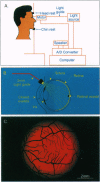Abstract
It has been known for more than 40 years that images fade from perception when they are kept at the same position on the retina by abrogating eye movements. Although aspects of this phenomenon were described earlier, the use of close-fitting contact lenses in the 1950s made possible a series of detailed observations on eye movements and visual continuity. In the intervening decades, many investigators have studied the role of image motion on visual perception. Although several controversies remain, it is clear that images deteriorate and in some cases disappear following stabilization; eye movements are, therefore, essential to sustained exoptic vision. The time course of image degradation has generally been reported to be a few seconds to a minute or more, depending upon the conditions. Here we show that images of entoptic vascular shadows can disappear in less than 80 msec. The rapid vanishing of these images implies an active mechanism of image erasure and creation as the basis of normal visual processing.
Full text
PDF



Images in this article
Selected References
These references are in PubMed. This may not be the complete list of references from this article.
- Andrews T. J., White L. E., Binder D., Purves D. Temporal events in cyclopean vision. Proc Natl Acad Sci U S A. 1996 Apr 16;93(8):3689–3692. doi: 10.1073/pnas.93.8.3689. [DOI] [PMC free article] [PubMed] [Google Scholar]
- Applegate R. A., Bradley A., van Heuven W. A. Entoptic visualization of the retinal vasculature near fixation. Invest Ophthalmol Vis Sci. 1990 Oct;31(10):2088–2098. [PubMed] [Google Scholar]
- DITCHBURN R. W., FENDER D. H., MAYNE S. Vision with controlled movements of the retinal image. J Physiol. 1959 Jan 28;145(1):98–107. doi: 10.1113/jphysiol.1959.sp006130. [DOI] [PMC free article] [PubMed] [Google Scholar]
- DITCHBURN R. W., GINSBORG B. L. Vision with a stabilized retinal image. Nature. 1952 Jul 5;170(4314):36–37. doi: 10.1038/170036a0. [DOI] [PubMed] [Google Scholar]
- Drysdale A. E. The visibility of retinal blood vessels. Vision Res. 1975 Jul;15(7):813–818. doi: 10.1016/0042-6989(75)90259-x. [DOI] [PubMed] [Google Scholar]
- HECKENMUELLER E. G. STABILIZATION OF THE RETINAL IMAGE: A REVIEW OF METHOD, EFFECTS, AND THEORY. Psychol Bull. 1965 Mar;63:157–169. doi: 10.1037/h0021743. [DOI] [PubMed] [Google Scholar]
- PRITCHARD R. M. Stabilized images on the retina. Sci Am. 1961 Jun;204:72–78. doi: 10.1038/scientificamerican0661-72. [DOI] [PubMed] [Google Scholar]
- Purves D., Paydarfar J. A., Andrews T. J. The wagon wheel illusion in movies and reality. Proc Natl Acad Sci U S A. 1996 Apr 16;93(8):3693–3697. doi: 10.1073/pnas.93.8.3693. [DOI] [PMC free article] [PubMed] [Google Scholar]
- RIGGS L. A., RATLIFF F., CORNSWEET J. C., CORNSWEET T. N. The disappearance of steadily fixated visual test objects. J Opt Soc Am. 1953 Jun;43(6):495–501. doi: 10.1364/josa.43.000495. [DOI] [PubMed] [Google Scholar]
- Robson J. G., Graham N. Probability summation and regional variation in contrast sensitivity across the visual field. Vision Res. 1981;21(3):409–418. doi: 10.1016/0042-6989(81)90169-3. [DOI] [PubMed] [Google Scholar]
- Sharpe C. R. The visibility and fading of thin lines visualized by their controlled movement across the retina. J Physiol. 1972 Apr;222(1):113–134. doi: 10.1113/jphysiol.1972.sp009790. [DOI] [PMC free article] [PubMed] [Google Scholar]




